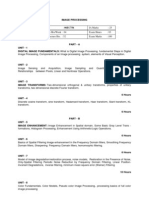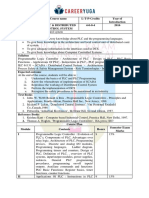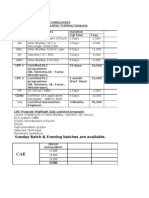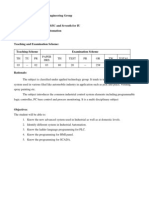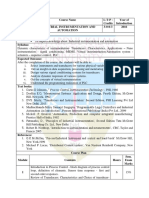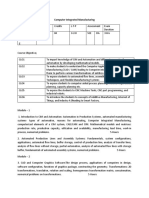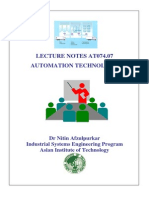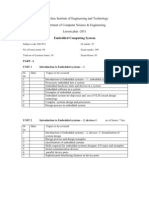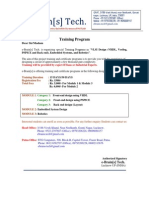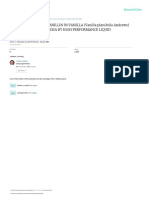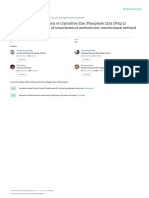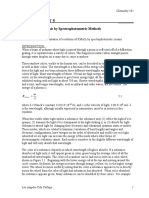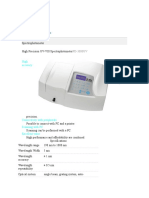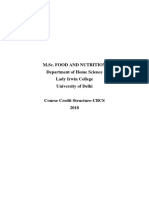7th 8th Syll With Objectivesa21.11.09acm
7th 8th Syll With Objectivesa21.11.09acm
Uploaded by
Kiran KumarCopyright:
Available Formats
7th 8th Syll With Objectivesa21.11.09acm
7th 8th Syll With Objectivesa21.11.09acm
Uploaded by
Kiran KumarCopyright
Available Formats
Share this document
Did you find this document useful?
Is this content inappropriate?
Copyright:
Available Formats
7th 8th Syll With Objectivesa21.11.09acm
7th 8th Syll With Objectivesa21.11.09acm
Uploaded by
Kiran KumarCopyright:
Available Formats
R.V.
COLLEGE OF ENGINEERING, BANGALORE-59 (Autonomous Institution under VTU, Belgaum) Department of Instrumentation Technology VII Semester ADVANCED PROCESS CONTROL AND AUTOMATION TECHNOLOGY AND LAB Sub Code: 07IT71 Hrs/Week: 3+1+3 Hrs Credits: 5 CIE Marks: 100 Exam Hours: 03 Hrs SEE Marks: 100+50
Objective: To understand the hardware & software programming aspects of different automation systems and their applications, PLC instructions & Programming, and introduction to SCADA, DCS, & Instrumentation Buses required for Automation. A course on Basic Microprocessors and process control are the pre-requisites for this course. Part A Introduction: Introduction to Automation, types & applications of Automation to process control, Introduction to Programmable Logic Controllers, PLC operation, Binary Data Representation, The input and output status files, Sixteen point I/O modules, PLC memory. 07 Hrs Ladder Logic & I/O Modules: Introduction to Logic, Conventional Ladder v/s PLC ladder diagrams, series and parallel functions of OR, AND, NOT, XOR logic, Analysis of rungs. Input modules: Discrete input modules, Discrete AC and DC input modules. Output Modules: Discrete output modules, solid state output module switching, relay output modules. 04 Hrs Relay Instructions & Interfacing: The basic relay instructions, Normally Open and Normally Closed instructions, Output latching instructions, Understanding Relay instructions and the programmable controller input modules- interfacing start/stop Pushbutton and Motor to PLC. 05 Hrs
Part B Special PLC Instructions: Timer and Counter Instructions: On delay and Off delay and retentive timer instructions, PLC Counter up and down instructions, combining counters and timers. Comparison and data Handling instructions: Data handling instructions, Sequencer instructions, Programming sequence output instructions. 06 Hrs Industrial Applications of PLCs: Temperature control, Valve Sequencing, Conveyor Belt control, Control of a process, Problems. 04 Hrs Computers in Process Control: Data Logging, Supervisory Control, and Computer Based Controller, Controller Software: Software Format, Input Data operations, Controller Modes, Computer Controller Examples. 06 Hrs
Part C Introduction to SCADA & DCS: Introduction to supervisory control and data acquisition (SCADA). Distributed control system (DCS), Evolution of digital controllers, computer network, interconnection of networks. 05 Hrs
Automation Bus Standards: Different BUS configurations used for industrial automation - RS485, CANBUS & its features, HART, OLE protocol, Industrial field bus, FIP (Factory Instrumentation protocol), PROFIBUS (Process field bus). 05 Hrs
Part D Practical Lab Experiments will be designed on the following topics: 1. Tuning of the Flow control, Temperature and Level control process loops. 2. Simulation of Bottle-filling process, Automatic Drilling Process and Elevator using PLC. Simulate using PLC. The logic should be solved using Ladder diagram technique. 3. Design of electronic temperature Indicator using AD590, Thermistor and Thermocouple. 4. Design of electronic strain Indicator. 5. Simulation of the Indication & Annunciation of Temperature measurement process and check the input temperature within the given range and set alarms, using Virtual Instrumentation graphical programming. 6. Simulation of the Indication & alarm Annunciation of Level measurement process, to check the Level of water within the given range and to display the Level at different instances of time & set alarms, using Virtual Instrumentation graphical programming. Reference Books: 1. Garry Dunning, Introduction to Programmable Logic Controllers - CENGAGE Learning, 3rd edition, 2009. 2. Curtis D Johnson, Process Control Instrumentation Technology - PHI, 8th edn, 2008. 3. Chidambaram M., Computer control of processes - Narosa publishing, 2nd edn, 2006. 4. Krishna Kant, Computer Based Industrial control - PHI, 2nd edn, 2006. 5. Bolton W., Industrial Control and Instrumentation - Universities Press, 4th edn, 2008. Scheme of Semester End Examination: Answer two questions out of three from Part A , two questions out of three from Part B and one question out of two from Part C in the theory exam. And one experiment from Part D needs to be conducted during the lab exam. Outcome of the Course:1. Importance of automation in process control, Basics of PLC organization, I/O modules of PLCs, becomes proficient in ladder programming, PLC instructions, & programming for a few industrial applications, understands how to develop software for computers based controllers, gets introduced to SCADA & DCS technologies & Standard Instrumentation Buses. 2. In the associated lab course, Tuning of PC-based PID-Controllers for effective control of (Temperature, flow & Level) processes, applications of PLCs, Techniques of signal conditioning, Calibation of designed electronic instruments, and generation of instrument specifications, as well as Virtual Instrumentation application to simulate simple processes using LabVIEW s/w.
R.V. COLLEGE OF ENGINEERING, BANGALORE-59 (Autonomous Institution under VTU, Belgaum) Department of Instrumentation Technology VII Semester DATA COMMUNICATION NETWORKS Sub Code: 07IT72 Hrs/Week: 4+0+0 Hrs Credits: 4 CIE Marks: 100 Exam Hours: 03 Hrs SEE Marks: 100
Objective: To provide a knowledge base for understanding the concepts of Data flow in the network by introducing various layers of Computer Networks and protocols defined for different layers, and also the concepts on Networking, Internet & Network security; Comprehensive skills and set a career in networking domain for Industries/Companies. Part A Introduction: Data Communications, Networks, The Internet, Protocols and Standards, Layered tasks, OSI model, Layers in the OSI model, TCP/IP protocol suite, Comparison of reference models 6 Hrs The Physical Layer: Transmission impairments, Data rate limits, Performance, Multiplexing: FDM, WDM, And TDM, Guided media: Twisted-pair cable, Coaxial cable, Fiber-Optic cable, Circuit switching, Packet switching. 8 Hrs The Medium Access Control (MAC) Sublayer: ALOHA, Carrier Sense Multiple Access (CSMA) protocols, Ethernet: Ethernet cabling, Manchester encoding, Ethernet MAC sublayer protocol, Binary exponential Backoff algorithm, Ethernet performance, Switched Ethernet. Fast Ethernet, Gigabit Ethernet 6 Hrs
Part B The Data Link Layer: Data link layer design issues, Error detection and Correction, Elementary Data Link Protocols, Sliding Window Protocols, Protocol Verification 6 Hrs The Network Layer: Network Layer Design Issues, Routing Algorithms: Optimality principle, Shortest path routing, Flooding, Distance vector routing, Link state routing, Hierarchical routing, General principles of congestion control, Prevention policies, QoS requirements, Techniques for achieving good Qos, Network layer in the Internet: IP protocol, IP address, IPv6. 8 Hrs Network Security: Introduction to Cryptography, Ciphers, one time pad, fundamental principles, Symmetric-Key algorithms: DES, AES, cipher modes, other ciphers. Communication security: IPsec, firewalls. Authentication protocols, E-mail security. 6 Hrs
Part C The Transport Layer: Transport service primitives, Berkely sockets, Socket programming, Elements of Transport protocols, Internet Transport Protocols: UDP and TCP: Service model, protocol, Segment header, connection establishment, connection release, connection management, Transmission policy, congestion control, Timer management. 6 Hrs The Application Layer: Domain name space, resource records, name servers, Electronic mail: Architecture and services, user agent, Message formats, message transfer, final delivery. World Wide
Web (WWW): Architecture, Static and Dynamic web documents, HTTP.
6 Hrs
Reference Books: 1. Andrews S. Tanenbaum, Computer Networks, 4th Edition, Pearson Education 2003 2. Behrouz A Forouzan. Data Communications and Networking, 4 th Edition, Tata McGraw-Hill 2006 3. W Stallings, Data and Computer Communications, 8th Edition, Pearson Education 2007 4. Wayne Tomasi, Introduction to Data Communications and Networking, Pearson Education 2005 Scheme of Semester End Examination: Answer two questions out of three from Part A , two questions out of three from Part B and one question out of two from Part C in the theory exam. Outcome of the Course:To demonstrate the applications of Data Communication Networks and to analyze, design, implement and experimentally validate the exchange of Information between various networks
R.V. COLLEGE OF ENGINEERING, BANGALORE-59 (Autonomous Institution under VTU, Belgaum) Department of Instrumentation Technology VII Semester REAL TIME SYSTEMS AND APPLICATIONS AND LAB Sub Code: 07IT73 Hrs/Week: 3+1+1 Hrs Credits: 5 CIE Marks: 100 Exam Hours: 03 Hrs SEE Marks: 100+50
Objective: The student understands the basic concepts of operating system, Real Time system, Real Time operating system associated with embedded system and also they understand the software and hardware design issues involved in the development of embedded system. Part A Basic Real-Time Concepts: Basic computer Architecture-Bus Transfer Mechanism, Input and Output, Memory, CPU Operation: some Terminology-software concepts, system concepts, Real-Time Definitions, Events and Determinism, Synchronous and Asynchronous Events, Determinism, TimeLoading; Real-Time Design issues, Hardware. 03 Hrs Real-Time specification and Design Techniques: Natural Languages: mathematical specification, Flow charts; structure charts; Pseudo code and Programming Design Languages; Finite state Automata; Data Flow Diagrams DeMarcos Rules, Hately and Pribhais extensions; Petri Nets; Warnier-orr NotationIndexed Loop;Statecharts-Depth,Orthogonality, Broadcast Communication; sanity in using Graphical Techniques. 07 Hrs Real-Time Kernels: Polled Loop System-Polled Loop with interrupts; Phase/state-Driven code; coroutines; Interrupt-Driven Systems context switching, Round-Robin Systems, Preemptive Priority Systems, Major and Minor cycles, Hybrid systems; Foreground-Background Systems-Background Processing, Initialization, Real-Time operation; Full-Featured Real Time operating Systems Task Control Block Model; Build or Buy POSIX. 06 Hrs
Part B Intertask communication and Synchronization: Buffering Data Time-Relative Buffering, Ring Buffers; Mailboxes- Mailbox Implementation, other operations on Mailboxes, Queues; Critical Regions; Mailboxes and semaphores, Counting Semaphores, problems with semaphores, The Test and set Instruction; Event Flags and Signals; Deadlock Avoidance, Detect and Recover. 06Hrs Real-Time Memory Management: Process stack Management, Task Control Block Model, Managing the stack, Run Time Ring Buffer, Maximum stack size, Multiple stack arrangements, Task control Block Model; Dynamic Allocation swapping,overlays,MFT,MVT,Demand Paging, working sets, Real-Time Garbage collection, contiguous file systems; static schemes. 10 Hrs
Part C Interrupt servicing mechanism: Context and the periods for context switching; deadline and interrupt latency. Language Features: Parameter passing, recursion, dynamic allocation, typing, exception handling, and abstract data typing. 05 Hrs
Case Studies: Case studies on Vxworks and MUCOS
05 Hrs
Part D Practical Lab Experiments will be designed on the following topics: The implementation of the following concepts using C language on Linux system. 1. IPC 2. Semaphore Networking: i. Write a C program to realize bit stuffing and De stuffing the character and bit ii. Write a C program to find shortest path between two nodes using shortest Path algorithm iii. Write a C program to detect and correct error using CRC method. iv. Write a C program to encrypt and decrypt a message using substitution and Transposition method Reference Books: 1. Philip A Laplante Real Time Systems Design and Analysis An Engineers Handbook, PHI Publications, Second edition, 2000. 2. Rajakamal Embedded Systems Architecture programming and design Tata McGraw Hill, 2004 3. Dr.K.V.K.K Prasad Embedded/ Real-Time systems: concepts, design and programming, dreamtech press, 2005. 4. Steve Heath, Embedded systems design, Second edition. 5. Krishna and shinkong Real-Time systems, McGraw Hill Publications, 2nd edition.
Scheme of Semester End Examination: After the completion of the course, the students will be able to understand and design hardware and software for an embedded system Outcome of the Course:Answer two questions out of three from Part A, two questions out of three from Part B and one question out of two from Part C in the theory exam.Conduct one experiment of Part D during Lab Exam.
R.V. COLLEGE OF ENGINEERING, BANGALORE-59 (Autonomous Institution under VTU, Belgaum) Department of Instrumentation Technology VII Semester WIRELESS COMMUNICATION Sub Code: 07IT741 Hrs/Week: 4+0+0 Hrs Credits: 4 CIE Marks: 100 Exam Hours: 03 Hrs SEE Marks: 100
Objective: The objective of this course is to introduce the concepts of wireless telecom systems and emerging wireless technologies GSM, CDMA technologies, cellular systems, architecture of wireless network and wireless LAN are dealt. Part A Introduction : Introduction to wireless telecommunication systems and Networks, History and Evolution Different generations of wireless cellular networks 1G, 2G, 3G and 4G networks. 6 Hrs Evolution of telephone systems : Common Cellular System components, Common cellular networks components, Hardware and software, views of cellular networks, 3G cellular systems components, and Cellular component identification Call establishment 7 Hrs Common Cellular Components: Wireless network architecture and operation, Cellular concept Cell fundamentals, Capacity expansion techniques, Cellular backbone networks, Mobility management, Radio resources and power management Wireless network security. 7 Hrs
Part B GSM Architecture : GSM and TDMA techniques, GSM system overview, GSM Network and system Architecture, GSM channel concepts, GSM identifier. 6 Hrs GSM Technology : GSM system operation, Traffic cases, Cal handoff, Roaming, GSM protocol architecture. TDMA systems 6 Hrs CDMA Technology : CDMA technologies, CDMA overview, operations. CDMA channel concept CDMA 8 Hrs
Part C Wireless Modulation techniques and Hardware: Characteristics of air interface, Path loss models, wireless coding techniques, Digital modulation techniques, OFDM, UWB radio techniques, Diversity techniques, Typical GSM Hardware. 6 Hrs Wireless LANs : Introduction to wireless LAN 802.11X technologies, Evolution of Wireless LAN Introduction to 802.15X technologies in PAN Application and architecture Bluetooth Introduction to Broadband wireless MAN, 802.16X technologies. 6 Hrs
Reference Books:
1. 2. 3. 4.
Mullet Wireless Telecom Systems and networks, Thomson Learning 2006. Lee W.C.Y Mobile Cellular Telecommunication, MGH, 2002. D P Agrawal Wireless communication,: 2nd Edition Thomson learning 2007. David Tse, Pramod Viswanath, Fundamentals of Wireless Communication Cambridge 2005
Scheme of Semester End Examination: Answer two questions out of three from Part A, two questions out of three from Part B and one question out of two from Part C in the theory exam. Outcome of the Course:Upon completion of this course the students would be able to know about the basics of wireless communication its different technologies and their applications used in the wireless media.
R.V. COLLEGE OF ENGINEERING, BANGALORE-59 (Autonomous Institution under VTU, Belgaum) Department of Instrumentation Technology VII Semester SOFTWARE ENGINEERING Sub Code: 07IT742 Hrs/Week: 4+0+0 Hrs Credits: 4 CIE Marks: 100 Exam Hours: 03 Hrs SEE Marks: 100
Objective: The objective of the subject to make the student to learn the basic life cycle of product development. It also deals with concepts like software products and software process. Part A Introduction to software engineering: Professional and ethical responsibility. Socio-Technical systems: Emergent system properties; Systems engineering; Organizations, people and computer systems; Legacy systems. 6 Hrs Critical Systems, Software Processes: Critical Systems: A simple safety-critical system; System dependability; Availability and reliability. Software Processes: Models, Process iteration, Process activities; The Rational Unified Process; Computer-Aided Software Engineering. 7 Hrs Software Requirements: Functional and Non-functional requirements; User requirements; System requirements; Interface specification; the software requirements document. Requirements Engineering Processes: Feasibility studies; Requirements elicitation and analysis; Requirements validation; Requirements management. 7 Hrs
Part B System models: Context models; Behavioral models; Data models; Object models; structured methods. Project Management: Management activities; Project planning; Project scheduling; Risk management 7 Hrs Software Design: Architectural Design: Architectural design decisions; System organization; Modular decomposition styles; Control styles. Object-Oriented design: Objects and Object Classes; An ObjectOriented design process; Design evolution; User Interface Design 7 Hrs Rapid Software Development and Evolution: Rapid Software Development: Agile methods; Extreme programming; Rapid application development. Software Evolution: Program evolution dynamics; Software maintenance; Evolution processes; Legacy system evolution. 6 Hrs
Part C Verification and Validation: Verification and Validation: Planning; Software inspections; Automated static analysis; Verification and formal methods. Software testing: System testing; Component testing; Test case design; Test automation. 6 Hrs Management: Managing People: Selecting staff; Motivating people; Managing people; The People Capability Maturity Model. Software Cost Estimation: Productivity; Estimation techniques; Algorithmic cost modeling, Project duration and staffing. 6 Hrs
Reference Books: 1. Ian Somerville Software Engineering, Pearson Education, 8th Edition, 2007. 2. Roger S. Pressman Software Engineering: A Practitioners Approach, McGraw-Hill, 7th Edition, 2007. 3. Shari Lawrence Pfleeger, Joanne M. Atlee Software Engineering Theory and Practice, Pearson Education, 3rd Edition 2006. 4. Waman S Jawadekar ,Software Engineering Principles and Practice, Tata McGraw Hill, 2nd Edition,2004 Scheme of Semester End Examination: Answer two questions out of three from Part A, two questions out of three from Part B and one question out of two from Part C in the theory exam. Outcome of the Course:Develop and simulate the models and validate its functionality in real time systems.
R.V. COLLEGE OF ENGINEERING, BANGALORE-59 (Autonomous Institution under VTU, Belgaum) Department of Instrumentation Technology VII Semester
ADAPTIVE SIGNAL PROCESSING
Sub Code: 07IT743 Hrs/Week: 4+0+0 Hrs Credits: 4 CIE Marks: 100 Exam Hours: 03 Hrs SEE Marks: 100
Objective: To understand the concepts of Adaptation with stationary signals, Adaptive Algorithms & structures and engineering applications of Adaptive Signal Processing. & develop the skills to design adaptive systems for advanced communication systems; various adaptive algorithms and Interference cancellation; design a filter for real time applications. Part A Adaptive Systems: Definition and characteristics, Areas of application, General properties, Open-and closed-loop adaptation, Applications of closed-loop adaptation, Example of an adaptive system. 4 Hrs The Adaptive Linear Combiner: General description, Input signal and weight vectors, Desired response and error, the performance function, gradient and minimum mean-square error, Example of a performance surface, Alternative expression of the gradient, Decorrelation of error and input components. 8 Hrs Quadratic Performance Surface: Normal of the input correlation matrix, Eigen values and Eigen vectors of the input correlation matrix, an example with two weights, Significance of Eigenvectors, Geometrical significance of eigenvectors and Eigen values. 5 Hrs Searching The Performance Surface: Methods of searching the performance surface, Basic ideas of gradient search methods, a simple gradient search algorithm and its solution, Stability and rate of convergence, the learning curve. 3 Hrs
Part B Gradient Search Algorithms: Newtons method in multidimensional space, Steepest descent method, Comparison of learning curves. 4 Hrs Gradient Estimation And Its Effects On Adaptation: Gradient component estimation by derivative measurement. The performance penalty, Derivative measurement and performance penalties with multiple weights, variance of the gradient estimate, effects on the weight-over solution, excess meansquare error and time constants, misadjustment, comparative performance of Newtons and steepestdescent methods, Total misadjustment and other practical considerations. 10 Hrs Adaptive Modeling And System Identification: General description, Adaptive modeling of multipath communication channel, adaptive modeling in geophysical exploration, Adaptive modeling in FIR digital filter synthesis. 10 Hrs
Part C The LMS Algorithm: Derivation of the LMS algorithm, convergence of the weight vector, an example
of convergence, learning curve, noise in the weight-vector solution, misadjustment, performance.
6 Hrs
Adaptive Interference Canceling: The concept of adaptive noise canceling, stationary noise-canceling solutions, effects of signal components in the reference input, The adaptive interference canceler as a notch filter, The adaptive interface canceler as a high-pass filter. 6 Hrs
Reference Books:
1. Bernard Widrow and Samuel D. Stearns, Adaptive Signal Processing, Pearson Education Asia, 2001. 2. Simon Haykin, Adaptive filter Theory, Pearson Education Asia, 4e, 2002 3. Jophn R. Treichler C. Richard Johnson, Jr. and Michael G. Larimore, Theory and Design of Adaptive Filters, Pearson education /PHI 2002. 4. A V Oppenheim, R W Schafer, Digital Signal Processing, Prentice Hall of India, 1975
Scheme of Semester End Examination: Answer two questions out of three from Part A, two questions out of three from Part B and one question out of two from Part C in the theory exam. Outcome of the Course:-
Designing the Adaptive systems, Filters for Real Time industrial Applications which are essential for the current industry needs.
R.V. COLLEGE OF ENGINEERING, BANGALORE-59 (Autonomous Institution under VTU, Belgaum) Department of Instrumentation Technology VII Semester OPERATIONS RESEARCH Sub Code: 07IT744 Hrs/Week: 4+0+0 Hrs Credits: 4 CIE Marks: 100 Exam Hours: 03 Hrs SEE Marks: 100
Objective: This course on OR mainly deals with the following optimization techniques, their mathematical models & industrial applications: Linear programming and applications, transportation and assignment problems and applications, game theory, replacement models, inventory models, PERT and CPM techniques, queuing models etc.so that productivity is improved and decision regarding maximizing the profits and minimizing the wastes and cost for an industry are learnt by the students. Part A Introduction: Definition, scope of operations research (O.R) approach and limitations of OR model, characteristic and phases of OR. 03 Hrs Linear programming problems: Mathematical formulation of LP problems, Graphical solution methods: The simplex method - slack, surplus and artificial variables. Concept of duality, 2 phase method, dual simplex method, degeneracy, and procedure for resolving generate cases, revised simplex method, sensitivity analysis, partial and dual, primal methods. 10 Hrs Transportation problem: Basic feasible solutions by different methods, finding optimal solutions stepping stone method, MODI method, degeneracy, unbalanced transportation problems, Assignment problems: Unbalanced assignment problem, traveling sales mans problems. 07Hrs
Part B Deterministic models with and without shortages, replenishment, meantime, ordering cost, carrying cost, EOQ. 07Hrs PERT CPM Techniques: Network construction, determining critical path, floats, scheduling by network, project duration, variance under probabilistic models, prediction of data completion, crashing of simple networks, resource leveling by network techniques. 07Hrs Waiting lines: Queuing systems and their characteristic, Poisson queues, M/M/1 Queuing system M/M/K model 6 Hrs
Part C Replacement model: Replacement of items whose maintenance cost increases with time. a) When value of money does not change with time, and b) When value of money changes with time, replacement of item that fail suddenly, group replacement policy. 06 Hrs Game theory: TWO person zero sum game, the max-min, mini-max principles, game without saddle
points, graphical solutions, two persons zero sum game, dominance property.
06 Hrs
Reference Books: 1. R.Ravindran Operation research Applications, operation research series,CRC Press, 2008, 2. P.K. Gupta and D.S. Hira Operation research an introduction, S CHAND & CO.,Ist edition, 2008 3. S C sharma Introductory operation Research ,Discovery publishing house, 2006. 4. Rassell Loncoln ,Ackoff,Maurince w Sasieni, Fundamentals of operation research,Wiley,1968 5. Hamdy a. Taha Introduction to operation research, Pearson., 2005 6. Kanti Swaroop, PK Gupta, Manmohan,Operations Research, 2 nd edition,Sultan chand and sons,1980 Scheme of Semester End Examination: Answer two questions out of three from Part A, two questions out of three from Part B and one question out of two from Part C in the theory exam. Outcome of the Course:The students will be able to solve the different exercises in optimization required for industrial situations & to take appropriate decisions, by applying suitable OR techniques.
R.V. COLLEGE OF ENGINEERING, BANGALORE-59 (Autonomous Institution under VTU, Belgaum) Department of Instrumentation Technology VII Semester LOW POWER VLSI DESIGN Sub Code: 07IT751 Hrs/Week: 4+0+0 Hrs Credits: 4 CIE Marks: 100 Exam Hours: 03 Hrs SEE Marks: 100
Objective: The objective of the course is to learn about the principles of design, analysis of modeling and optimization of low power VLSI. Power dissipation has become as important a consideration as performance and area. Low-power technology improves battery size and design, electronic packaging of ICs, heat dissipation, and circuit reliability. It describes many issues for the designers at architectural, logic, circuit and device levels. Part A Introduction: Sources of power dissipation, Physics of power dissipation in MOSFET devices MIS Structure, Long channel and sub-micron MOSFET, Gate induced Drain leakage. 8 Hrs Power dissipation in CMOS : Short circuit dissipation, dynamic dissipation, Load capacitance 6 Hrs Low power design limits - Principles of low power design, Hierarchy of limits, fundamental limits, Material, device, circuitands ystemlimits. 6 Hrs
Part B Synthesis for low power: Behavioral, Logic and Circuit level approaches, Algorithm level transforms, Power-constrained Least squares optimization for adaptive and non-adaptive filters, Circuit activity driven architectural transformations, voltage scaling, operation reduction and substitution, precomputation, Finite State Machine and Combinational logic, Transistor sizing. 10 Hrs Design and test of low-voltage CMOS circuits: Introduction, Design style, Leakage current in Deep sub-micron transistors, device design issues, minimizing short channel effect, Low voltage design techniques using reverse Vgs, steep sub threshold swing and multiple threshold voltages, Testing with elevated intrinsic leakage, multiple supply voltages. 10 Hrs
Part C Low energy computing: Energy dissipation in transistor channel, Energy recovery circuit design, designs with reversible and partially reversible logic, energy recovery in adiabatic logic and Static Random Access Memory core, Design of peripheral circuits address decoder, level shifter and I/O Buffer, supply clock generation. 6 Hrs Software design for low power: Introduction, sources of power dissipation, power estimation and optimization 6 Hrs
Reference Books: 1. Kaushik Roy and Sharat C Prasad, Low-Power CMOS VLSI Circuit Design Wiley Inter
science, 2000. 2. Gary. K. Yeap Practical low power digital VLSI design Kluwer Academic Publishers. 2002. 3. Rabaey, pedram Low Power design methodologies Kluwer Academic, 1997. 4. Neil H.E Weste and David Harris, CMOS VLSI DesignA Circuit and System Perspective, Pearson Education, 3rd edition, 2005.
Scheme of Semester End Examination: Answer two questions out of three from Part A, two questions out of three from Part B and one question out of two from Part C in the theory exam. Outcome of the Course:The students will be familiar with the methodologies used for designing low power circuits and systems. It concludes with the future challenges that must be met to design low power, high performance systems.
R.V. COLLEGE OF ENGINEERING, BANGALORE-59 (Autonomous Institution under VTU, Belgaum) Department of Instrumentation Technology VII Semester ARTI FICIAL INTELLIGENCE Sub Code: 07IT752 Hrs/Week: 4+0+0 Hrs Credits: 4 CIE Marks: 100 Exam Hours: 03 Hrs SEE Marks: 100
Objective: The objective of the subject to make the student to introduce the basic knowledge representation, problem solving and learning method of artificial intelligent. This course also deals with the development of intelligent system by assembling solution to concrete computational problems. Part A Artificial Intelligence: Introduction, definition, underlying assumption, importance of AI, AI related fields. 6 Hrs Space Representation: Defining a problem. Production systems and its characteristics, Search and Control strategies Generate and Test, Hill Climbing, Best first Search, Problem reduction, Constraint Satisfaction, Means Ends Analysis. 7 Hrs Knowledge Representation Issues: Representations and Mappings, Types of knowledge Procedural Vs Declarative, Logic programming. Forward Vs Backward reasoning, matching. 7 Hrs
Part B Use of Predicate Logic: Representing simple facts, Instance and Isa relationships, Syntax and Semantics for Prepositional logic, FQPL and properties of Wffs, Conversion to Clausal form, Resolution, Natural deduction. 6 Hrs Statistical And Probabilistic Reasoning: Symbolic reasoning under uncertainty, Probability and Bayes theorem, Certainity factors and Rule based systems, Bayesian Networks, Shafer Theory, Fuzzy Logic. 7 Hrs Expert Systems: Structure and uses, Representing and using domain knowledge, Expert System Shells. Pattern recognition learning classification patterns, recognizing and understanding speech. Introduction to knowledge Acquisition, Types of Learning. 7 Hrs
Part C Typical Expert Systems: Mycin, Variant of Mycin, Prospector, Dendral, Puff, Etc 6 Hrs
Introduction to Machine Learning: Perceptrons, Checker Playing Examples, Learning Automata, Genetic Algorithms, Intelligent Editors. 6 Hrs
Reference Books:
1. 2. 3. 4.
Elaine Rich & Kevin Knight, Artificial Intelligence, McGraw-Hill, 2nd Edition, 1983. Dan W. Patterson, Introduction to AI & ES, Prentice Hall of India, 1999. Waterman, D.A., Addison A guide to expert systems, Wesley inc., 1986. Roth, Waterman, D.A. Addison Hayes, Building expert systems, Wesley, 1983.
Scheme of Semester End Examination: Answer two questions out of three from Part A, two questions out of three from Part B and one question out of two from Part C in the theory exam. Outcome of the Course:Demonstrate and ability to integrate different concepts to develop new models that suits current trends of Industries and analyze its performance.
R.V. COLLEGE OF ENGINEERING, BANGALORE-59 (Autonomous Institution under VTU, Belgaum) Department of Instrumentation Technology VII Semester DATABASE MANAGEMENT Sub Code: 07IT753 Hrs/Week: 4+0+0 Hrs Credits: 4 CIE Marks: 100 Exam Hours: 03 Hrs SEE Marks: 100
Objective: The objective of the subject to make the student to introduce the basic concept of database system including data abstraction, data modeling and three level architecture. It also deal with database management system such as Microsoft Access and Oracle. Part A Introduction; An example; Characteristics of Database approach; Actors on the screen; Workers behind the scene; Advantages of using DBMS approach; A brief history of database applications; when not to use a DBMS. Data models, schemas and instances; Three-schema architecture and data independence; Database languages and interfaces; the database system environment; Centralized and client-server architectures; Classification of Database Management systems. 6 Hrs Entity-Relationship Model Using High-Level Conceptual Data Models for Database Design; An Example Database Application; Entity Types, Entity Sets, Attributes and Keys; Relationship types, Relationship Sets, Roles and Structural Constraints; Weak Entity Types; Refining the ER Design; ER Diagrams, Naming Conventions and Design Issues; Relationship types of degree higher than two. 6 Hrs Relational Model and Relational Algebra Relational Model Concepts; Relational Model Constraints and Relational Database Schemas; Update Operations, Transactions and dealing with constraint violations; Unary Relational Operations: SELECT and PROJECT; Relational Algebra Operations from Set Theory; Binary Relational Operations : JOIN and DIVISION; Additional Relational Operations; Examples of Queries in Relational Algebra; Relational Database Design Using ER- to-Relational Mapping. 8 Hrs
Part B SQL - 1 SQL Data Definition and Data Types; Specifying basic constraints in SQL; Schema change statements in SQL; Basic queries in SQL; More complex SQL Queries. 8 Hrs SQL 2 Insert, Delete and Update statements in SQL; Specifying constraints as Assertion and Trigger; Views (Virtual Tables) in SQL; Additional features of SQL; Database programming issues and techniques; Embedded SQL, Dynamic SQL; Database stored procedures and SQL / PSM. 6 Hrs Database Design - 1 Informal Design Guidelines for Relation Schemas; Functional Dependencies; Normal Forms Based on Primary Keys; General Definitions of Second and Third Normal Forms; BoyceCodd Normal Form. 6 Hrs
Part C Database Design -2 Properties of Relational Decompositions; Algorithms for Relational Database Schema Design; Multivalued Dependencies and Fourth Normal Form; Join Dependencies and Fifth
Normal Form; Inclusion Dependencies; Other Dependencies and Normal Forms.
4 Hr
Transaction Management The ACID Properties; Transactions and Schedules; Concurrent Execution of Transactions; Lock-Based Concurrency Control; Performance of locking; Transaction support in SQL; Introduction to crash recovery; 2PL, Serializability and Recoverability; Lock Management; Introduction to ARIES; The log; Other recovery-related structures; The write-ahead log protocol; Check pointing; Recovering from a System Crash; Media Recovery; Other approaches and interaction with concurrency control. 8 Hrs
Reference Books: 1. Elmasri and Navathe,Fundamentals of Database Systems, Addison-Wesley, 5th Edition, 2007. 2. Raghu Ramakrishnan and Johannes Gehrke, Database Management Systems, McGraw-Hill, 3rd Edition, 2003. 3. Silberschatz, Korth and Sudharshan, Data base System Concepts, Mc-GrawHill, 5th Edition, 2006. 4. C.J. Date, A. Kannan, S. SwamynathamA Introduction to Database Systems,, Pearson Education, 8th Edition ,2006. Scheme of Semester End Examination: Answer two questions out of three from Part A, two questions out of three from Part B and one question out of two from Part C in the theory exam. Outcome of the Course:The ability for the analysis and evaluation of the best practices of the engineering projects
R.V. COLLEGE OF ENGINEERING, BANGALORE-59 (Autonomous Institution under VTU, Belgaum) Department of Instrumentation Technology VII Semester MICRO ELECTRO MECHANICAL SYSTEMS Sub Code: 07IT753 Hrs/Week: 4+0+0 Hrs Credits: 4 CIE Marks: 100 Exam Hours: 03 Hrs SEE Marks: 100
Objective:MEMS technology is fast emerging field today. It is used in all fields. To name a few: Automobile, Aerospace, Medical application apart from various robotics, artificial intelligence areas, etc. This is because of the reduction in size as well as the reduced power requirements in the Instrumentation and Control Automation areas.The objective of the course is to give an overview of MEMS technology emphasizing the future growth and to highlight Various manufacturing techniques involved in MEMS structure.Also to study few Commercial MEMS products to understand the practical applications and introduce .Simulation software concept in design of the MEMS systems . Part A Introduction to micro and smart systems: introduction to smart systems. Components, structures and systems for MEMS.. Application areas Examples of microsystems. Feynmans vision. Evolution of MEMS transducers. Manufacturing. Techniques for MEMS,architecture of commercial products 8 Hrs Micro and smart devices: basics principles of physics, chemistry, engineering of sensors, actuators and systems. Sensors: silicon capacitive accelerometer, piezo- resistive pressure sensor. Conduct metric gas sensor, fiber optic gyroscope and wave based wireless strain sensor. Actuators: silicon micro-mirror arrays, piezo- electric based inkjet print head, electrostatic comb drive and micro motor, magnetic micro relay, shape memory alloy based actuator, electro thermal actuator. Systems: micro gas turbine, bio applications of MEMS. 8 Hrs Micro manufacturing and material processing: silicon wafer processing, lithography, thin film Deposition, etching (wet and dry) wafer bonding and metallization. Silicon micro machining: Surface, bulk, molding, bonding based process flows. Thick film processing. 4 Hrs
Part B Processing of smart material. Special techniques for processing: ceramics, polymers and metals. Latest trends on micro fabrication. 7 Hrs
Scaling fundamentals. Deformation, stress analysis of beams and plates, residual stresses and stress gradients. Thermal loading, heat transfer issues. Micro fluidics fundamentals,Electrostatics, electro mechanics. Electromagnetic actuation.Capillary electrophoresis. Modeling of piezoresistive piezo electric systems. 6 Hrs Semiconductor devices:Carrier concentrations in semiconductor diodes, transistors.fet amplifiers, operational amplifiers. Basic opamp circuits. Charge measuring circuits. Examples of microsystems. Transfer function, state space modeling, stability, pid controllers and model order reduction. Examples from smart systems and micro machined accelerometer or a thermal cycler 7 Hrs
Part C Integration and packaging of MEMS. Integration of microelectronics and micro devices at wafer and chip level microelectronic packaging: wire and ball bonding, flip chip, multi chip module technolog Lab on Chip. Introduction Bio MEMS . 6 Hrs Case Studies: BEL Pressure Sensor, Thermal Cycler for DNA Amplification and Active Vibration Control Of a beam. Introduction to Simulation softwares. 6 Hrs
Reference Books: 1. Tai-ran tsu MEMS & Microsystems: Design and manufacture. John Wiley and sons Inc, 2008 2nd edition. 2. V.vardan, K.J.Vinoy, S.Gopalakrishnan Smart Material Systems And Mems : Design And Development Methodologies. John Wiley. And Sons ltd, 2004. (Ch.1,2,9,10,11,12.) 3. Stevens S. Saliterman. Fundamentals of Bio MEMS and Medical and Micro devices. Wiley Interscience division. 2006, first edition. 4. Kasap. S.O. Principles of Electrical Engineering Materials. Irwin, Chicago, 1997. Scheme of Semester End Examination: Answer two questions out of three from Part A, two questions out of three from Part B and one question out of two from Part C in the theory exam. Outcome of the Course:Students will get an overview of MEMS Technology. Their will be clarity in the Basic Principles used in MEMS, Like Physics, Chemistry, Applied Dynamics, Structure analysis etc. Students will have ability to design MEMS structure using the software. They will be able to get them manufactured in standard MEMS furnaces/labs and check them for performance.
R.V. COLLEGE OF ENGINEERING, BANGALORE-59 (Autonomous Institution under VTU, Belgaum) Department of Instrumentation Technology VII Semester ANALYTICAL INSTRUMENTATION Sub Code: 07IT761 Hrs/Week: 4+0+0 Hrs Credits: 4 CIE Marks: 100 Exam Hours: 03 Hrs SEE Marks: 100
Objective: The main objective is to measure and understand the properties & reactions of chemical compositions of solids, liquids, gases , compounds and mixtures. Various techniques are introduced for measurement and analysis of chemical compounds like spectroscopy, x-ray techniques, nuclear measurements, chromatography and mass spectroscopy. Part A Introduction: Types of analytical methods, instruments for analysis, electromagnetic radiation, its properties and interaction with matter, Emission of radiation. 2 Hrs Spectroscopy: An introduction to absorption, spectroscopic, photometry, beer Lambarts law. Application of Photometry to analysis. UV, visible spectra photometry theory and instrumentation, application of UV, visible spectrophotometry to qualitative and quantitative analysis. Infrared spectrophotometry theory and instrumentation IR instrument components, Single beam, Double beam recording type.Application to quantitative analysis, some typical instruments. 8 Hrs Flame emission and atomic absorption spectroscopy: Principles, Instrumentation, Flames and Flame temperatures, Interferences, standard addition and internal standard methods of evaluation. 6 Hrs Emission spectrography: Arc spark and plasma sources, prism and grating instruments, application to identification. 4 Hrs
Part B -ray techniques: Introduction to X-ray absorption, Fluorescence, Spectroscopy, Wavelength and X energy dispersive instruments, non-dispersive instruments, x-ray diffraction and its applications. 5 Hrs Nuclear radiation measurements: radiation detectors, ionization chamber, GM counter proportional counter, scintillation counters, and Semi conductor detectors. 5 Hrs Chromatographic techniques: Introduction, Gas chromatography, Instrumentation, Types of columns and detectors. 10 Hrs
Part C Electro analytical methods: Introduction, Polarography, dropping mercury electrodes, anodic stripping, conductometry, applications. 4 Hrs Nuclear Magnetic Resonance spectroscopy: Principles of NMR, Wideline NMR, NMR spectra, Chemical shift and hyper fine splitting, applications. 4 Hrs Mass spectrometry: ion sources, Inlet systems, mass analyzers, single beam, double beam, quadrapole -
applications
4 Hrs
Reference Books: 1. Willard H.W Merritt, L.L Dean J A Settie FA Instrument Methods of Analysis, East West Publisher, 6th Edition, 1992 2. Douglas A Skoog , F.James Holler, Stanley R.Crouch Principles of Instrumentation Analysis, Thomson Brooks, 6 th Edition, 2006. 3. Douglas A Skoog, Donald M, Fundamentals of analytical chemistry, Thomson, 8th Edition,2003. 4. Galen W Ewing Instrumental Methods of Chemical Analysis, ,Mc-Graw Hill, 4th Edition 1975
Scheme of Semester End Examination: Answer two questions out of three from Part A, two questions out of three from Part B and one question out of two from Part C in the theory exam. Outcome of the Course:Students will be familiar with chemical analysis and the techniques involved in it.
R.V. COLLEGE OF ENGINEERING, BANGALORE-59 (Autonomous Institution under VTU, Belgaum) Department of Instrumentation Technology VII Semester COMPUTER ARCHITECTURE Sub Code: 07IT762 Hrs/Week: 4+0+0 Hrs Credits: 4 CIE Marks: 100 Exam Hours: 03 Hrs SEE Marks: 100
Objective: computer architecture is concerned with the design and performance of the computer system as a whole. It can enhance students' understanding of the role of design features in achieving high performance. The design of the system starts from building blocks which include basic processor, memories of various performance levels, input and output devices and interconnection buses. The prerequisite is to know about data representation, digital components and digital circuits. Part A Basic Structure of Computers Functional units - Basic operational concepts - Bus structures - Software performance Memory locations and addresses Memory operations Instruction and instruction sequencing Addressing modes Assembly language Basic I/O operations Stacks and queue 6 Hrs Arithmetic Unit Addition and subtraction of signed numbers Design of fast adders Multiplication of positive numbers - Signed operand multiplication and fast multiplication Integer division Floating point numbers and operations. 6 Hrs Basic Processing Fundamental concepts Execution of a complete instruction Multiple bus organization Hardwired control Micro programmed control - Pipelining Basic concepts Data hazards Instruction hazards Influence on Instruction sets Data path and control consideration Superscalar operation. 8 Hrs
Part B Memory System Basic concepts Semiconductor RAMs - ROMs Speed - size and cost Auxiliary memories magnetic discs, magnetic tape 4 Hrs Cache Memory Associative mapping, direct mapping, set-associative mapping, writing into cache, cache initialization 4 Hrs Virtual memory- address space, memory space address mapping using pages, associative memory page table, page replacement 4 Hrs I/O Organization Accessing I/O devices Interrupts Direct Memory Access Buses DMA controller,DMA transfer, input output organization interface circuits standard i/o interfaces (PCI, SCSI, USB). 8 Hrs
Part C Advanced Prosessor ArchitecturesIntroduction, RISC Processors, Pipelining, delay in pipeline execution, superscalar processors, VLIW processors, some examples commercial processors
6 Hrs Parallel Computer Introduction, classification of parallel computers, vector computer, Array processors, Shared memory parallel computers, distributed shared memory parallel computer, clusters of workstations comparisons of parallel computers. 6 Hrs
Reference Books: 1. V, Rajaraman, T.Radhakrishnan,Computer organization and architecturePHI, Ist Edition 2008. 2. M.Moris Mano , Computer system architecture Pearson Education,3rd edition,2003. 3. V Heuring & H Jordan, Computer System Design & Architecture Addison- Wesley, 2005, 2nd Edition. 4. Carl Hamacher, Z Vranesic & S Zaky Computer Organization- Tata McGrawHill. 2005, 5thEdition Scheme of Semester End Examination: Answer two questions out of three from Part A, two questions out of three from Part B and one question out of two from Part C in the theory exam. Outcome of the Course:-
Understanding these fundamental concepts in computer architecture is essential to learning computer networking.
R.V. COLLEGE OF ENGINEERING, BANGALORE-59 (Autonomous Institution under VTU, Belgaum) Department of Instrumentation Technology VII Semester BIOINFORMATICS AND APPLICATIONS Sub Code: 07IT763 Hrs/Week: 4+0+0 Hrs Credits: 4 CIE Marks: 100 Exam Hours: 03 Hrs SEE Marks: 100
Objective: This subject deals with the storage, retrieval and analysis of biological data with informatics tools. The student understands interdisciplinary approach, requiring software knowledge, computer science, mathematics and statistical methods with a functional understanding of the biological and chemical context at the molecular level. Part A The central dogma: Watsons definition, information flow, from data to knowledge, the organization of DNA and RNA, the organization of Proteins. 3 Hrs XML (BioXML) for Bioinformatics. Introduction, Differences between HTML and XML, fundamentals of XML, fundamentals of XML namespaces. Introduction to DTDs, Document type Declarations, Declaring elements, declaring attributes, working with entities XML Schemas, Essential Concepts, working with simple types, working with complex types, Basic namespaces issues 7 Hrs Perl (Bioperl) for Bioinformaics: Representing sequence data, program to store a DNA sequence, concatenating DNA fragments, Transcription, Calculating the reverse complement in Perl, Proteins,files, reading proteins in files, Arrays, Flow control ,finding motifs, counting Nucleotides, exploding strings into arrays, operating on strings, writing to files, subroutines and bugs. 10 Hrs Part B Databases. Flat file, Relational, object oriented databases, object Relational and Hypertext, Data life cycle, Database Technology, SQL, Database Architecture, Database Management Systems and Interfaces. 10 Hrs Sequence Alignment algorithms: Biological motivations of sequence analysis, the models for sequence analysis and their biological motivation, global alignment,local alignment, End free-space alignment and gap penalty, Sequence Analysis tools and techniques. 10 Hrs
Part C Phylogenetic Analysis: Introduction, methods of Phylogenetic analysis, distance methods, the neighbour- Joining (NJ) method, The Fitch/ Margoliash method, character-based methods, Other methods, Tree evaluation and problems in phylogenetic analysis. 6 Hrs Clustering, Protein structure visualization and Protein structure prediction. 6 Hrs
Reference Books: 1. 1.S.C.Rastogi, N. Mendiratta,Bioinformatics Methods and Applications, 2 nd Edition
2. 3. 4. 5.
EEE ,2006 2 Ethan Ceami,XML for Bioinformatics, Springer Verlag, 2005. 3.James D. Tisdall.,Beginning Perl for Bioinformatics, first edition, Orelly, 2001 4.Bryan Bergeron M.D. Bioinformatics Computing, Pearson Education, 2003
Scheme of Semester End Examination: Answer two questions out of three from Part A, two questions out of three from Part B and one question out of two from Part C in the theory exam. Outcome of the Course:The students are able to develop database and software tools for the storage, analysis and interpretation of biological data.
R.V. COLLEGE OF ENGINEERING, BANGALORE-59 (Autonomous Institution under VTU, Belgaum) Department of Instrumentation Technology VII Semester DATA MINING AND ITS APPLICATIONS Sub Code: 07IT764 Hrs/Week: 4+0+0 Hrs Credits: 4 CIE Marks: 100 Exam Hours: 03 Hrs SEE Marks: 100
Objective: The understand the importance of database and its management and also knowing the basic concepts of Data ware house and data mining, the different techniques and issues involved in data mining. Part A Introduction to Data Mining: Motivation and importance, What is Data Mining, Relational Databases, Data Ware houses, Transactional Databases, Advanced Database Systems and Advanced Database Applications, Data Mining Functionalities, Interestingness of a pattern Classification of Data Mining Systems, Major issues in Data Mining 7 Hrs Data Preprocessing: Needs Preprocessing the Data, Data Cleaning, Data Integration and transformation, Data Reduction, Discretization and Concept Hierarchy Generation, Online Data Storage 5 Hrs Data Mining Primitives, Languages and System Architectures: Data Mining Primitives, Data Mining Query Languages, Designing Graphical User Interfaces Based on a Data Mining Query Language Architectures of Data Mining Systems. 8 Hrs
Part B Concepts Description: Characterization and Comparison: Data Generalization and SummarizationBased Characterization, Analytical Characterization, Analysis of Attribute Relevance, Mining Class Comparisons, Discriminating between Different Classes, Mining Descriptive Statistical Measures in Large Databases 8 Hrs Mining Association Rules in Large Databases: Association Rule Mining, Mining Single-Dimensional Boolean Association Rules from Transactional Databases, Mining Multilevel Association Rules from Transaction Database.Mining Multidimensional Association Rules from Relational Databases and Data Warehouses, From Association Mining to Correlation Analysis, Constraint Based Association Mining. 12 Hrs
Part C Classification and Prediction, Concepts and Issues regarding Classification and Prediction, Classification by Decision Tree Induction, Bayesian Classification, Classification by Back-propagation. 6 Hrs Cluster Analysis, Types of Data in Cluster Analysis, A Categorization of Major Clustering Methods. 6 Hrs Reference Books:
1. Jiawei han & micheline kamber Data Mining Concepts and Techniques Harcourt India, 2006. 2. Arun k pujari, Data Mining Techniques University Press, 2006 3. Sam anahory & Dennis murray Data Warehousing in the Real World , Pearson Edn. Asia, 2003. 4. Margaret h dunham ,Data Mining Introductory and advanced topics, Pearson Education,2005. Scheme of Semester End Examination: Answer two questions out of three from Part A, two questions out of three from Part B and one question out of two from Part C in the theory exam. Outcome of the Course:The students will be able to design and develop data mining algorithms.
R.V. COLLEGE OF ENGINEERING, BANGALORE-59 (Autonomous Institution under VTU, Belgaum) Department of Instrumentation Technology VIII Semester PRINCIPLES OF INTELLECTUAL PROPERTY RIGHTS Sub Code: 07HSS81 Hrs/Week: 2+0+0 Hrs Credits: 2 CIE Marks: 50 Exam Hours: 02 Hrs SEE Marks: 50
Objective: To encourage invention, investment and innovation and disclosure of New Technology and to recognise and reward innovativeness. To promote innovation and technical development. To promote linkages to industries and stimulate research through developing and utilizing novel technologies Part A Introduction: Basic concepts of IPR, Nature and scope of IPR, Commercial exploitation of IPR, IPR and economic development, Types of Intellectual property, Advantages of IPR, Intellectual property in specific fields Plant breeders rights, Plant variety protection, A brief history national and international legal regime governing industrial and Intellectual property 3 Hrs Patents: Introduction, Basic concepts, Object and value of patent law, Advantages of patent to inventor, patentable inventions, inventions are not patentable, How to obtain patent, Biotechnology patents and patents on computer program, Government use of inventions, Infringement of patents and remedy for infringement, Case study for patent engineering. Patent Acts 1970 as amended in 1999, 2002, & 2005. 7 Hrs Trade Marks: Basic concepts, Definition, Functions, different kinds of trade marks like service marks, collective trade marks, certification trade marks and textile trade marks, registrable and non registrable marks, Establishing trade mark right, use and registration, Registrability &distinctive character, Good will, infringement and action for trade marks, Passing off, Trade mark and domain names, Comparison with patents, industrial design and copy right, Case Studies. 5 Hrs Copy Right: Introduction, Nature and scope, Subject matter, Related or allied rights, the works in which copy right subsists, Rights conferred by copy right, Copy right protection in India, transfer of copy rights, right of broad casting organisations and of performer, computer soft ware and IPR and Case Studies. 6 Hrs Industrial Design, Integrated Circuits, Geographical Indications and Confidential information: Introduction, basic concepts and scope and nature of rights process of registration rights, available after registration, transfer of interest or rights, made available under respective legislations such as assignment, transmission and licenses; Reliefs and Remedies and Action for infringementoftherights;Appeals,Casestudies 5 Hrs
Reference Books:
1. P Narayan, Intellectual Property Law, Eastern Law House, New Delhi and Kolkata, 2005, EAN, 9788171771813. 2. Prabuddha Ganguly, Intellectual Property Rights: Unleashing Knowledge Economy, Tata McGraw Hill Publishing Company Ltd., New Delhi, 1st Edition, 2001. ISBN: 0074638602. 3. Cornesh W .R, Intellectual Property Rights Patents, Copy Right, Trade Mark, Allied Rights, Universal Law Publishing Company Pvt. Ltd, Delhi, 2001. 4. S.R Myneni, Law of Intellectual Property, Asia Law House, Hyderabad, 2001 Web 1.Using the Internet for non-patent prior art searches, Derwent IP Matters, July 2000. [www.ipmatters.net/features/000707_gibbs.html.] 2. Patents by N.R.Subbaram, Pharma book syndicate. 3. www.iptoday.com
Scheme of Semester End Examination: Question paper will be set to cover both descriptive and objective questions, with weightage of 40% for objective and 60% for descriptive questions Outcome of the Course: Articulate the applicable source, scope and limitations of the core Intellectual Property disciplines such as Patent, Copyright, Trademark and Trade secret Law. Exposure to various Legal issues pertaining to Intellectual Property Rights
R.V. COLLEGE OF ENGINEERING, BANGALORE-59 (Autonomous Institution under VTU, Belgaum) Department of Instrumentation Technology VIII Semester PRINCIPLES OF INTELLECTUAL PROPERTY RIGHTS Sub Code: 07HSS81 Hrs/Week: 2+0+0 Hrs Credits: 2 CIE Marks: 50 Exam Hours: 02 Hrs SEE Marks: 50
Objective: To encourage invention, investment and innovation and disclosure of New Technology and to recognise and reward innovativeness. To promote innovation and technical development. To promote linkages to industries and stimulate research through developing and utilizing novel technologies Part A Introduction: Basic concepts of IPR, Nature and scope of IPR, Commercial exploitation of IPR, IPR and economic development, Types of Intellectual property, Advantages of IPR, Intellectual property in specific fields Plant breeders rights, Plant variety protection, A brief history national and international legal regime governing industrial and Intellectual property 3 Hrs Patents: Introduction, Basic concepts, Object and value of patent law, Advantages of patent to inventor, patentable inventions, inventions are not patentable, How to obtain patent, Biotechnology patents and patents on computer program, Government use of inventions, Infringement of patents and remedy for infringement, Case study for patent engineering. Patent Acts 1970 as amended in 1999, 2002, & 2005. 7 Hrs Trade Marks: Basic concepts, Definition, Functions, different kinds of trade marks like service marks, collective trade marks, certification trade marks and textile trade marks, registrable and non registrable marks, Establishing trade mark right, use and registration, Registrability &distinctive character, Good will, infringement and action for trade marks, Passing off, Trade mark and domain names, Comparison with patents, industrial design and copy right, Case Studies. 5 Hrs Copy Right: Introduction, Nature and scope, Subject matter, Related or allied rights, the works in which copy right subsists, Rights conferred by copy right, Copy right protection in India, transfer of copy rights, right of broad casting organisations and of performer, computer soft ware and IPR and Case Studies. 6 Hrs Industrial Design, Integrated Circuits, Geographical Indications and Confidential information: Introduction, basic concepts and scope and nature of rights process of registration rights, available after registration, transfer of interest or rights, made available under respective legislations such as assignment, transmission and licenses; Reliefs and Remedies and Action for infringementoftherights;Appeals,Casestudies 5 Hrs
Reference Books:
5. P Narayan, Intellectual Property Law, Eastern Law House, New Delhi and Kolkata, 2005, EAN, 9788171771813. 6. Prabuddha Ganguly, Intellectual Property Rights: Unleashing Knowledge Economy, Tata McGraw Hill Publishing Company Ltd., New Delhi, 1st Edition, 2001. ISBN: 0074638602. 7. Cornesh W .R, Intellectual Property Rights Patents, Copy Right, Trade Mark, Allied Rights, Universal Law Publishing Company Pvt. Ltd, Delhi, 2001. 8. S.R Myneni, Law of Intellectual Property, Asia Law House, Hyderabad, 2001 Web 1.Using the Internet for non-patent prior art searches, Derwent IP Matters, July 2000. [www.ipmatters.net/features/000707_gibbs.html.] 2. Patents by N.R.Subbaram, Pharma book syndicate. 3. www.iptoday.com
Scheme of Semester End Examination: Question paper will be set to cover both descriptive and objective questions, with weightage of 40% for objective and 60% for descriptive questions Outcome of the Course: Articulate the applicable source, scope and limitations of the core Intellectual Property disciplines such as Patent, Copyright, Trademark and Trade secret Law. Exposure to various Legal issues pertaining to Intellectual Property Rights
R.V. COLLEGE OF ENGINEERING, BANGALORE-59 (Autonomous Institution under VTU, Belgaum) Department of Instrumentation Technology VIII Semester SEMINAR Sub Code: 07ITS83 Hrs/Week: 3+0+0 Hrs Credits: 2 General Guidelines for the seminar The seminar has to be presented by individual students. The topics of seminar should based on current thrust area, Each student has to prepare an IEEE Paper out of seminar topic. The student need to submit both the soft and hard copy of seminar report
Split up of CIE marks Topics Relevance of topic Presentation Report IEEE Paper Outcome of the Course:Marks 10 25 5 10
R.V. COLLEGE OF ENGINEERING, BANGALORE-59 (Autonomous Institution under VTU, Belgaum) Department of Instrumentation Technology VIII Semester PROJECT WORK Sub Code: 07ITP84 Hrs/Week: 24+0+0 Hrs Credits: 12 General Guidelines for Project Work The project work is to be carried out by a team of three to four students. Each student in the team must contribute synergistically towards successful completion of the project. The project may be carried out in an Industry / R&D Institution / In-House. In case of external projects, specific approval from the department is necessary. The House projects would be proposed by the department and the students are required to select a project from the list. InThe project could be software based or hardware based relevant to the field of instrumentation. The student team is required to submit hard copies of the detailed Project Report in the prescribed format as well as softcopy on a CD. The student team is required to demonstrate the functioning of the modules and the integrated application along with a presentation on the details of the project carried out to the respective internal guide before the semester end examination. CIE Marks: 100 Exam Hours: 03 Hrs SEE Marks: 100
Split up of CIE marks Topics Preliminary Seminar Intermediate seminar Demonstration Report Final seminar Marks 15 20 15 10 40 Things to be done Present the synopsis with literature survey Present the progress of the project Working model of project Submit the report in Proper format. Presentation and viva
Scheme for SEE: Student needs to present seminar with the results for the SEE.
You might also like
- IMPCA Ref Spec 01 July 2021Document16 pagesIMPCA Ref Spec 01 July 2021Magno GuzmanNo ratings yet
- Analy Food Colour Uv-VisDocument13 pagesAnaly Food Colour Uv-VisNoor Zarif100% (1)
- Industrial Control Syllabus PDFDocument2 pagesIndustrial Control Syllabus PDF287 JatinNo ratings yet
- Catalogo CECILDocument96 pagesCatalogo CECILCespi-peru Sac80% (5)
- O.M. - 14.0 - BT1000 - BT1500 - BT2000 Plus - BT3000 - Plus - BT3500 PDFDocument280 pagesO.M. - 14.0 - BT1000 - BT1500 - BT2000 Plus - BT3000 - Plus - BT3500 PDFmessaoud_fethi80% (10)
- Ip AesdDocument4 pagesIp AesdSumanth SathyanarayanaNo ratings yet
- Programmable Logic Controllers (PLC) EEE220 PDFDocument7 pagesProgrammable Logic Controllers (PLC) EEE220 PDFTanaka dzapasi100% (1)
- Postgraduate M E Instrumentation and ControlDocument8 pagesPostgraduate M E Instrumentation and Controljricardo019763535No ratings yet
- Course Specification: Se425 Distributed Control SystemDocument10 pagesCourse Specification: Se425 Distributed Control SystemAmmar AlkindyNo ratings yet
- PLCs and AutomationDocument2 pagesPLCs and AutomationKhaja JamalNo ratings yet
- 2008-09 Sem-II Paper-1 Distributed Control SystemDocument2 pages2008-09 Sem-II Paper-1 Distributed Control SystemMahendra PandeyNo ratings yet
- By Anusha K S: LECTURE 1 (Introduction To Automation)Document10 pagesBy Anusha K S: LECTURE 1 (Introduction To Automation)GODWIN TOMNo ratings yet
- Logic and Distributed PDFDocument3 pagesLogic and Distributed PDFAbhijith SreekumarNo ratings yet
- Print OutDocument11 pagesPrint OutKamlesh SilagNo ratings yet
- Swe2002 Computer-Networks Eth 1.0 37 Swe2002Document4 pagesSwe2002 Computer-Networks Eth 1.0 37 Swe2002Naveen VnvNo ratings yet
- Industrial Automation Train in IngDocument11 pagesIndustrial Automation Train in IngGopala KrishnanNo ratings yet
- Eee481 - Fa09 - CCSDocument3 pagesEee481 - Fa09 - CCSSai KamalaNo ratings yet
- Industrial AutomationDocument4 pagesIndustrial AutomationmeghasugauliNo ratings yet
- Eee 481 2015Document2 pagesEee 481 2015Bhavna MuthyalaNo ratings yet
- Industrial AutomationDocument4 pagesIndustrial AutomationNarayanan IyerNo ratings yet
- 6 1Document19 pages6 1Zubair AhmedNo ratings yet
- PLCDocument1 pagePLCRumana AliNo ratings yet
- PLC K SaraswathiDocument105 pagesPLC K SaraswathiKoushik SgNo ratings yet
- Syllabus MTX TE Mech Engg (2019)Document3 pagesSyllabus MTX TE Mech Engg (2019)subhash2025khetreNo ratings yet
- Ee404 Industrial Instrumentation and AutomationDocument3 pagesEe404 Industrial Instrumentation and AutomationArya RahulNo ratings yet
- Microcontroller Architecture and Organization: Unit IDocument6 pagesMicrocontroller Architecture and Organization: Unit IhemanthdreamzNo ratings yet
- PLC Course ContentDocument5 pagesPLC Course ContentMahesh GonuguntlaNo ratings yet
- MT Embedded Diploma ContentsDocument8 pagesMT Embedded Diploma ContentsAhmed HamoudaNo ratings yet
- DsceDocument12 pagesDsceqwertr707936No ratings yet
- BDBC ContentDocument32 pagesBDBC ContentManoj YadavNo ratings yet
- SyllabusDocument23 pagesSyllabusSanjivanNo ratings yet
- 7th - Sem - CSE CsvtuDocument18 pages7th - Sem - CSE CsvtuGold KnowinNo ratings yet
- Embedded - Software - Testing - Training - PlanDocument14 pagesEmbedded - Software - Testing - Training - PlanshivamNo ratings yet
- Computer Science and Engineering 3rd Year - Pub - Date - 15092019 PDFDocument8 pagesComputer Science and Engineering 3rd Year - Pub - Date - 15092019 PDFSabbirNo ratings yet
- Sandeepalani Course of 16 WeeksDocument3 pagesSandeepalani Course of 16 WeeksNitesh JadhavNo ratings yet
- Advance Computer Architecture & Peripherals: Duration 3 Hours 3 1 2 6 70 22Document7 pagesAdvance Computer Architecture & Peripherals: Duration 3 Hours 3 1 2 6 70 22Yogendra AgnihotriNo ratings yet
- EE 316 SyllabusDocument3 pagesEE 316 SyllabusJeya MuraliNo ratings yet
- Bcse305l Embedded-Systems TH 1.0 67 Bcse305l 2Document3 pagesBcse305l Embedded-Systems TH 1.0 67 Bcse305l 2Harisankar R N RNo ratings yet
- TECP3851-Microprocessor and Programmable Logic ControllersDocument1 pageTECP3851-Microprocessor and Programmable Logic ControllersSteveNo ratings yet
- Teaching Model-Based Design and Rapid Prototyping To Undergraduate StudentsDocument6 pagesTeaching Model-Based Design and Rapid Prototyping To Undergraduate StudentsMKTR_AHMETNo ratings yet
- Designing and Impli .Menting Scada Subsystem For Textile IndustryDocument4 pagesDesigning and Impli .Menting Scada Subsystem For Textile IndustryWajid KhattakNo ratings yet
- Vishwakarma Institute of TechnologyDocument23 pagesVishwakarma Institute of TechnologyEr Shubham RaksheNo ratings yet
- BE Mechanical Syllabus FinalDocument2 pagesBE Mechanical Syllabus FinalsabnisnileshNo ratings yet
- Third Year Sem A Sem B UpdatedDocument40 pagesThird Year Sem A Sem B UpdatedArpitNo ratings yet
- Computer Integrated ManufacturingDocument3 pagesComputer Integrated ManufacturingsatheeshNo ratings yet
- Presented by The ISA Montreal Section: A Practical Introduction To Instrumentation and AutomationDocument4 pagesPresented by The ISA Montreal Section: A Practical Introduction To Instrumentation and AutomationMullerggmNo ratings yet
- Lec1 PLCDocument67 pagesLec1 PLCmayarm802No ratings yet
- I 0 PrinciplesAutomationTechnology PDFDocument5 pagesI 0 PrinciplesAutomationTechnology PDFZoran LalkovicNo ratings yet
- Ae361 Virtual Instrument DesignDocument2 pagesAe361 Virtual Instrument DesignGlan DevadhasNo ratings yet
- Supervisory Control & Data AcquisitionDocument34 pagesSupervisory Control & Data AcquisitionThuân Phạm NgọcNo ratings yet
- Saya Suka AwakDocument6 pagesSaya Suka AwakNazif JaafarNo ratings yet
- Lesson PlanDocument6 pagesLesson PlanMeenakshi HnNo ratings yet
- Detailed List & Syllabuses of Courses: Syrian Arab Republic Damascus UniversityDocument12 pagesDetailed List & Syllabuses of Courses: Syrian Arab Republic Damascus UniversitySedra MerkhanNo ratings yet
- 8th Semester CSE SyllabusDocument3 pages8th Semester CSE SyllabusYuva RajNo ratings yet
- Jatin Mer CVDocument7 pagesJatin Mer CVsumitNo ratings yet
- E Brains DetailsDocument4 pagesE Brains DetailsJyoti HaveliyaNo ratings yet
- 5th Sem Course SyllabusDocument9 pages5th Sem Course SyllabusSahiti DarikaNo ratings yet
- VTH Sem SyllabusDocument6 pagesVTH Sem Syllabusjk494189No ratings yet
- La Verificacion de Sistemas DigitalesDocument19 pagesLa Verificacion de Sistemas DigitalesinghectorrNo ratings yet
- Design Automation of Cyber-Physical SystemsFrom EverandDesign Automation of Cyber-Physical SystemsMohammad Abdullah Al FaruqueNo ratings yet
- Advanced Dynamic-System Simulation: Model Replication and Monte Carlo StudiesFrom EverandAdvanced Dynamic-System Simulation: Model Replication and Monte Carlo StudiesNo ratings yet
- Introduction to Quantum Computing & Machine Learning Technologies: 1, #1From EverandIntroduction to Quantum Computing & Machine Learning Technologies: 1, #1No ratings yet
- Heliyon: Amira F. El-Yazbi, Karin M. Guirguis, Mona M. Bedair, Tarek S. BelalDocument10 pagesHeliyon: Amira F. El-Yazbi, Karin M. Guirguis, Mona M. Bedair, Tarek S. BelalWentySafitriNo ratings yet
- 7 DETERMINATION OF VANILLIN IN VANILLA (Vanilla Planifolia Andrews) From Lampung Indonesia by High Performance Liquid ChromatographyDocument5 pages7 DETERMINATION OF VANILLIN IN VANILLA (Vanilla Planifolia Andrews) From Lampung Indonesia by High Performance Liquid ChromatographydeviNo ratings yet
- 22 Paint Technology Handbook: UmmaryDocument2 pages22 Paint Technology Handbook: Ummarybmittal30No ratings yet
- Atomic Absorption SpectrosDocument12 pagesAtomic Absorption Spectrosandira diraNo ratings yet
- W2 - Spectroscopic-Based MethodsDocument45 pagesW2 - Spectroscopic-Based MethodsJason Yap Han YuenNo ratings yet
- A New Spectrophotometric Method For TheDocument17 pagesA New Spectrophotometric Method For TheFadhil FerdianNo ratings yet
- Analysis of Metals, Ores, and Related Materials by Molecular Absorption SpectrometryDocument7 pagesAnalysis of Metals, Ores, and Related Materials by Molecular Absorption SpectrometryAnkit PatelNo ratings yet
- Chapter 2 MOLECULAR ABSORPTION SPECTROSDocument134 pagesChapter 2 MOLECULAR ABSORPTION SPECTROSaisyahNo ratings yet
- Intensification of Synthesis of Crystalline Zinc Phosphate (Zn3 (PO4) 2) Nanopowder: Advantage of Sonochemical Method Over Conventional MethodDocument6 pagesIntensification of Synthesis of Crystalline Zinc Phosphate (Zn3 (PO4) 2) Nanopowder: Advantage of Sonochemical Method Over Conventional MethodGwen WalkerNo ratings yet
- Experiment 5 - : Quantitative Analysis by Spectrophotometric MethodsDocument7 pagesExperiment 5 - : Quantitative Analysis by Spectrophotometric MethodsBryanNo ratings yet
- Analytical Equipment: High AccuracyDocument6 pagesAnalytical Equipment: High AccuracyMartin ClydeNo ratings yet
- E107 PDFDocument17 pagesE107 PDFEduardo MoralesNo ratings yet
- Method Development For Visible Spectrophotometric Analysis of Ibuprofen in PharmaceuticalsDocument4 pagesMethod Development For Visible Spectrophotometric Analysis of Ibuprofen in PharmaceuticalsCristian-Catalin GavatNo ratings yet
- Exp 2-Starch Hydrolysis by AmylaseDocument6 pagesExp 2-Starch Hydrolysis by AmylaseDodi Ihsan TaufiqNo ratings yet
- Spectrophotometric Determination of Total Proteins inDocument4 pagesSpectrophotometric Determination of Total Proteins inLaifa RahmawatiNo ratings yet
- Advanced Pharmaceutics: International Journal ofDocument8 pagesAdvanced Pharmaceutics: International Journal ofdini hanifaNo ratings yet
- Uv Visiblespectroscopyppt 170925144657Document58 pagesUv Visiblespectroscopyppt 170925144657meenu sruthi priyaNo ratings yet
- HPLC BetalainDocument26 pagesHPLC BetalainLODH HITESHNo ratings yet
- LIC - Home Science PDFDocument628 pagesLIC - Home Science PDFRahul ChaudharyNo ratings yet
- Modified Lowry Protein AssayDocument6 pagesModified Lowry Protein AssaywakeyNo ratings yet
- Alves Et Al 2019Document8 pagesAlves Et Al 2019gtenienteNo ratings yet
- Spectronic 501 601 SpectrophotometerDocument24 pagesSpectronic 501 601 Spectrophotometermohamed abdelzaherNo ratings yet
- Cc2lab Sodium Potassium Quiz WT RevDocument13 pagesCc2lab Sodium Potassium Quiz WT RevJHON JORIES VISMONTENo ratings yet
- Biochem Lab Report Experiment 1Document5 pagesBiochem Lab Report Experiment 1marymcauley6No ratings yet
- G1134 Ed2.1 Surface Colours Used As Visual Signals On AtoN December 2017Document40 pagesG1134 Ed2.1 Surface Colours Used As Visual Signals On AtoN December 2017Ilmiyawan SyafNo ratings yet





